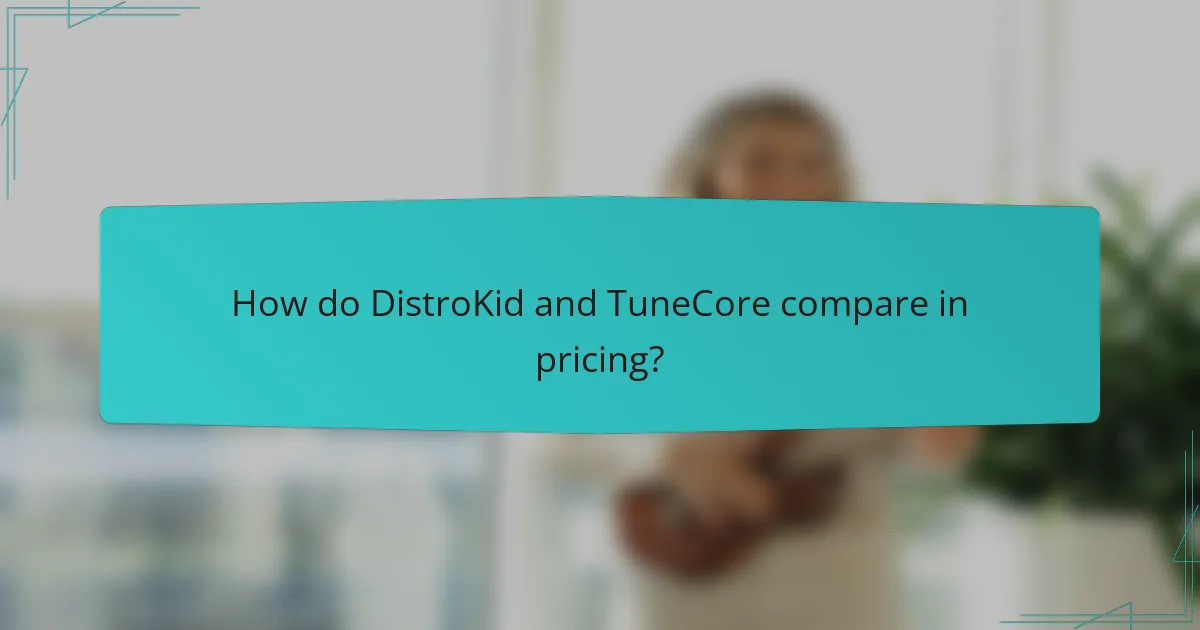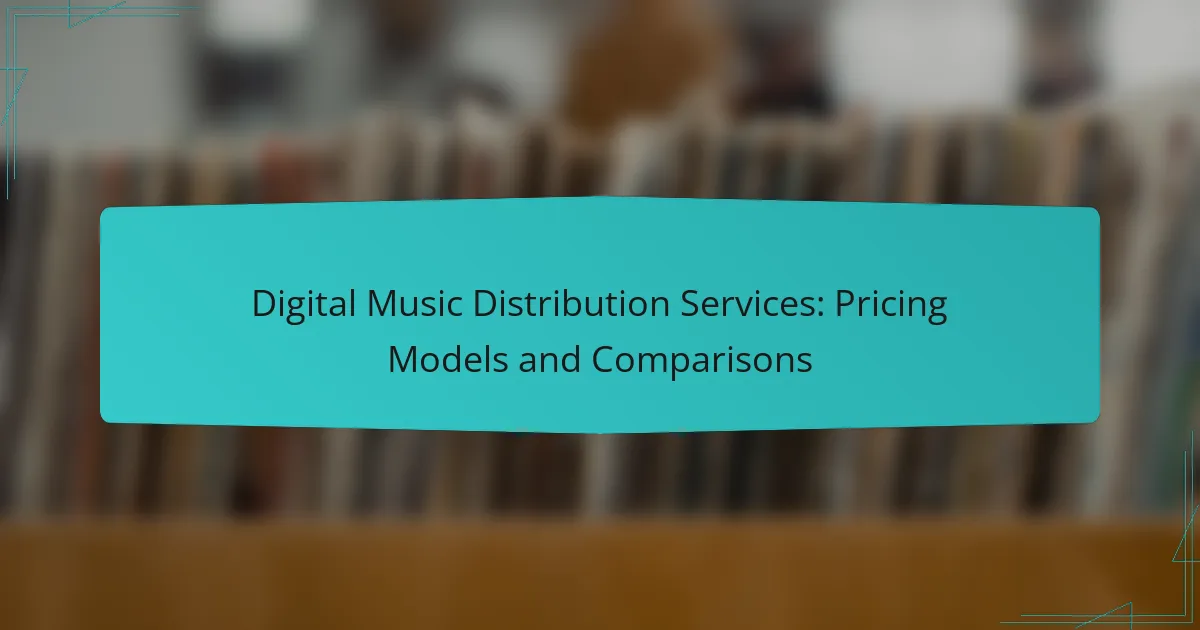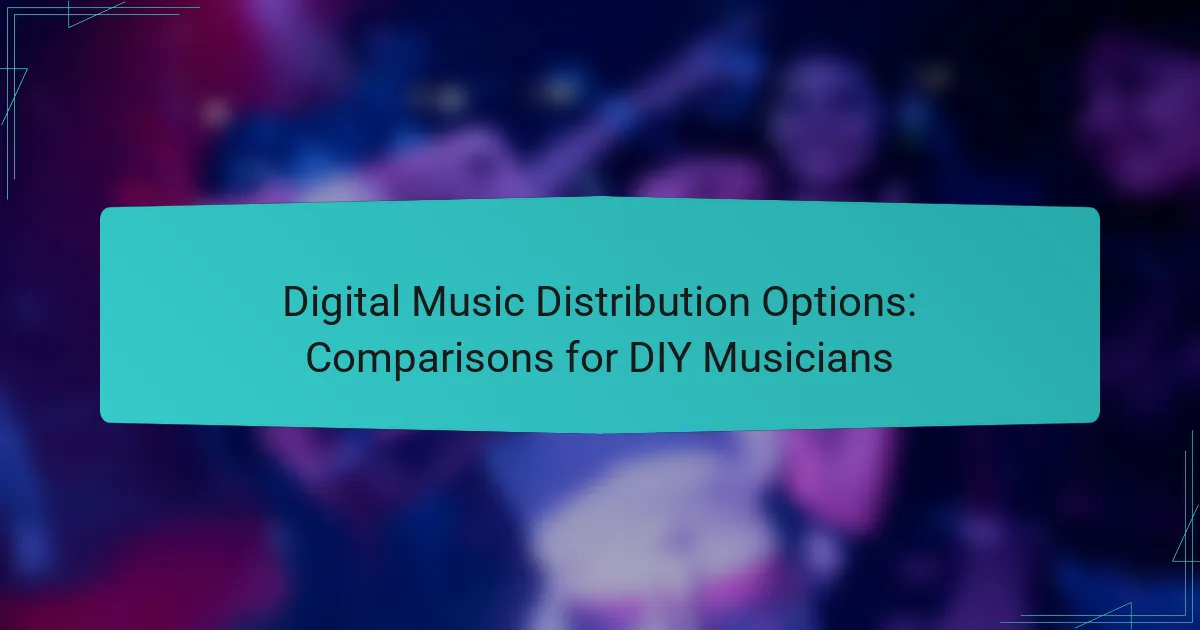Digital music distribution services play a crucial role in helping artists share their music across multiple platforms, each offering distinct pricing models and features. By exploring options like DistroKid, TuneCore, CD Baby, Amuse, and Landr, musicians can find the best fit for their needs and financial goals. Understanding the differences in distribution reach, royalty rates, and additional services is essential for maximizing visibility and earnings in the competitive digital marketplace.

What are the best digital music distribution services?
The best digital music distribution services help artists distribute their music across various platforms while offering different pricing models and features. Key services include DistroKid, TuneCore, CD Baby, Amuse, and Landr, each with unique advantages and considerations for musicians.
DistroKid
DistroKid is known for its straightforward pricing model, charging a flat annual fee that allows artists to upload unlimited music. This service is ideal for those who release music frequently, as it enables artists to keep 100% of their earnings from streaming and sales.
One of DistroKid’s standout features is its fast distribution, often getting music onto platforms like Spotify and Apple Music within a few days. However, artists should be aware that DistroKid does not offer physical distribution options.
TuneCore
TuneCore operates on a pay-per-release model, charging fees for each single or album uploaded. This can be beneficial for artists who release music less frequently, as they only pay when they need to distribute new content.
While TuneCore allows artists to retain 100% of their sales revenue, the upfront costs can add up if multiple releases are planned. Additionally, TuneCore provides detailed analytics, which can help artists track their performance across platforms.
CD Baby
CD Baby offers a one-time fee for distribution, allowing artists to keep a significant portion of their earnings. This service is well-suited for musicians who prefer a more traditional approach, as it also provides options for physical distribution and publishing services.
CD Baby takes a percentage of sales, which varies based on the distribution type chosen. Artists should consider this when evaluating potential earnings, especially if they plan to sell physical copies of their music.
Amuse
Amuse offers a unique model by providing free distribution for artists, with the option to upgrade to a paid plan for additional features. This makes it an attractive choice for emerging artists looking to enter the market without upfront costs.
However, the free version has limitations, such as slower release times and fewer analytics. Artists who want more control and insights may find the paid plans worthwhile, which include faster distribution and enhanced promotional tools.
Landr
Landr combines digital distribution with music mastering services, making it a convenient option for artists looking to streamline their production process. The pricing is subscription-based, allowing access to various features, including unlimited distribution and mastering.
While Landr’s all-in-one approach is appealing, artists should evaluate whether they need both distribution and mastering services. The subscription model may be cost-effective for those who regularly release music but could be less advantageous for occasional releases.

How do pricing models differ among digital music distribution services?
Digital music distribution services offer various pricing models, each with unique advantages and considerations. Understanding these differences can help artists choose the best option for their needs and financial goals.
Flat fee models
Flat fee models charge artists a set amount, typically on an annual basis, regardless of the number of releases. This approach allows for predictable budgeting and can be cost-effective for artists with multiple releases throughout the year.
For instance, a service might charge around $20 to $50 per year for unlimited uploads. This model is ideal for independent musicians who plan to release several tracks or albums, as it eliminates the worry of incurring additional costs with each release.
Percentage of royalties
Percentage of royalties models take a cut from the earnings generated by the music, usually ranging from 10% to 30%. This model aligns the distributor’s success with the artist’s, as both parties benefit from higher sales.
However, artists should consider the trade-off of potentially higher long-term costs, especially if their music becomes popular. For example, if an artist earns $1,000 in royalties, a 15% fee would result in a $150 payment to the distributor.
Pay-per-release
Pay-per-release models charge artists a fee for each individual release, which can vary widely based on the service. This option is suitable for artists who release music infrequently or want to test the waters with a single track.
Fees can range from $5 to $50 per release, depending on the platform and additional services offered, such as marketing or promotional tools. Artists should weigh the upfront costs against their expected return to determine if this model fits their release strategy.

What factors should I consider when choosing a digital music distribution service?
When selecting a digital music distribution service, consider distribution reach, royalty rates, and additional services offered. These factors will significantly impact your music’s visibility, earnings, and overall support in the digital marketplace.
Distribution reach
Distribution reach refers to the number of platforms and territories where your music will be available. A service with extensive reach can help you access major streaming platforms like Spotify, Apple Music, and Amazon Music, as well as smaller niche sites.
Evaluate whether the service distributes to international markets, as this can broaden your audience. Some services may focus on specific regions, which could limit your potential listener base.
Royalty rates
Royalty rates determine how much you earn from your music sales and streams. Different distribution services have varying models, such as taking a percentage of your earnings or charging a flat fee per release.
Common royalty splits range from 10% to 30% for the distributor, while some platforms offer 100% of royalties for a fixed annual fee. Assess which model aligns best with your financial goals and expected sales volume.
Additional services
Many distribution services provide extra features that can enhance your music career. These may include marketing tools, analytics, and access to sync licensing opportunities.
Consider whether you need promotional support or data insights to track your performance. Some services offer these features as part of their package, while others may charge extra, so weigh the benefits against the costs.

How do DistroKid and TuneCore compare in pricing?
DistroKid and TuneCore offer distinct pricing models for digital music distribution, catering to different needs and budgets. DistroKid typically charges an annual fee for unlimited uploads, while TuneCore uses a per-release pricing structure, which can add up depending on the number of songs or albums an artist distributes.
DistroKid pricing structure
DistroKid operates on a subscription model, charging artists an annual fee that allows for unlimited music uploads. This fee generally ranges from around $20 to $50 per year, depending on the plan selected, with additional costs for extras like YouTube monetization or Shazam integration.
One key advantage of DistroKid is that artists keep 100% of their royalties, making it a cost-effective option for those planning to release multiple tracks throughout the year. However, the annual fee means that artists need to consistently release music to justify the cost.
TuneCore pricing structure
TuneCore employs a pay-per-release model, charging artists for each single or album they distribute. The cost for a single typically starts around $10, while an album can range from $30 to $50, depending on the number of tracks and additional services chosen.
This model can be beneficial for artists who release music infrequently, as they only pay when they have new content. However, for those planning to release multiple projects, the costs can accumulate quickly, making it a less economical choice compared to DistroKid’s flat rate.

What are the advantages of using CD Baby for distribution?
CD Baby offers independent artists a straightforward way to distribute their music across various platforms while retaining control over their rights. Key advantages include a user-friendly interface, a wide reach to digital stores, and additional services that enhance revenue opportunities.
One-time fees
CD Baby operates on a one-time fee model, meaning artists pay upfront for distribution without ongoing royalties. Typically, this fee ranges from around $9 to $49 per album, depending on the package chosen. This structure allows artists to keep 100% of their earnings from sales and streams after the initial payment.
It’s essential to consider the potential for additional costs, such as fees for extra services like physical distribution or promotional tools. Artists should weigh these options against their budget and distribution goals.
Sync licensing opportunities
CD Baby provides artists with access to sync licensing opportunities, which can be a lucrative revenue stream. By partnering with various media outlets, CD Baby helps artists get their music placed in films, TV shows, and commercials. This can significantly increase exposure and income.
Artists interested in sync licensing should ensure their music is properly registered and consider submitting tracks that fit popular genres for media use. Engaging in this aspect can enhance overall earnings beyond traditional streaming and sales.

What are the unique features of Amuse?
Amuse offers a range of distinctive features that cater to independent musicians seeking to distribute their music digitally. Its user-friendly platform, free distribution option, and artist-centric approach make it a popular choice for emerging artists.
Free distribution option
Amuse provides a free distribution option that allows artists to release their music on major streaming platforms without upfront costs. This model is particularly appealing for new musicians who may have limited budgets.
While the free option is accessible, artists should be aware that Amuse retains a percentage of the royalties generated from their music. Typically, this percentage can range from 15% to 20%, which is a trade-off for the lack of initial fees.
For those considering Amuse, it’s advisable to evaluate how the royalty split aligns with their financial goals. Artists may want to compare this model with other services that offer flat-fee distributions to determine the best fit for their needs.



